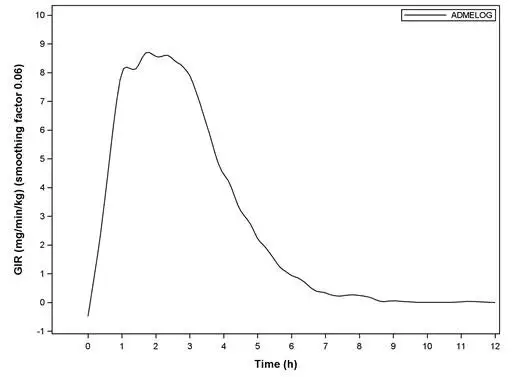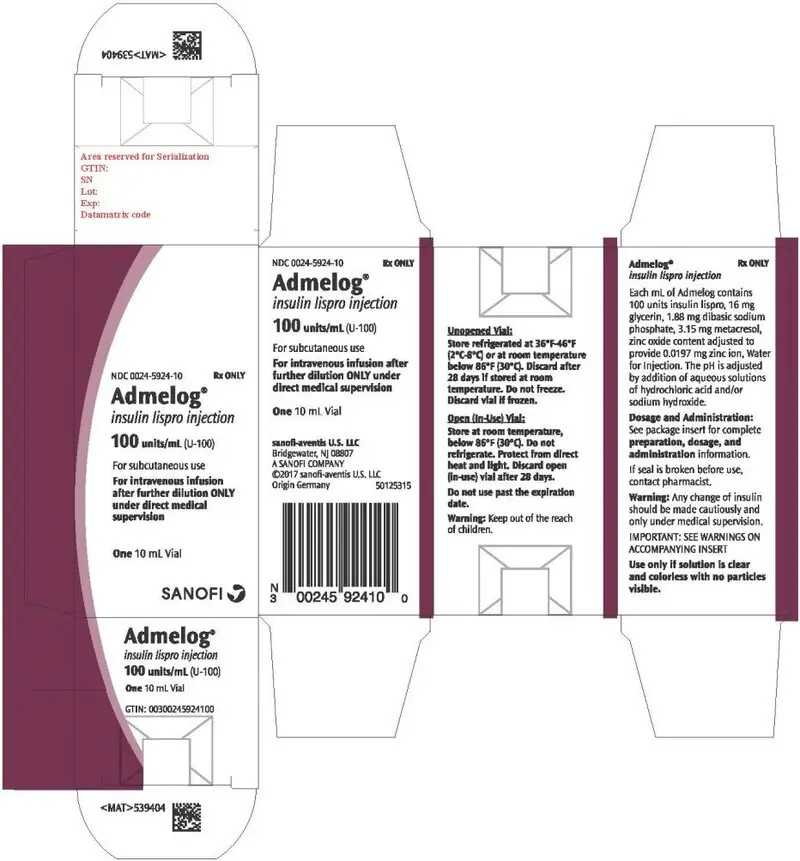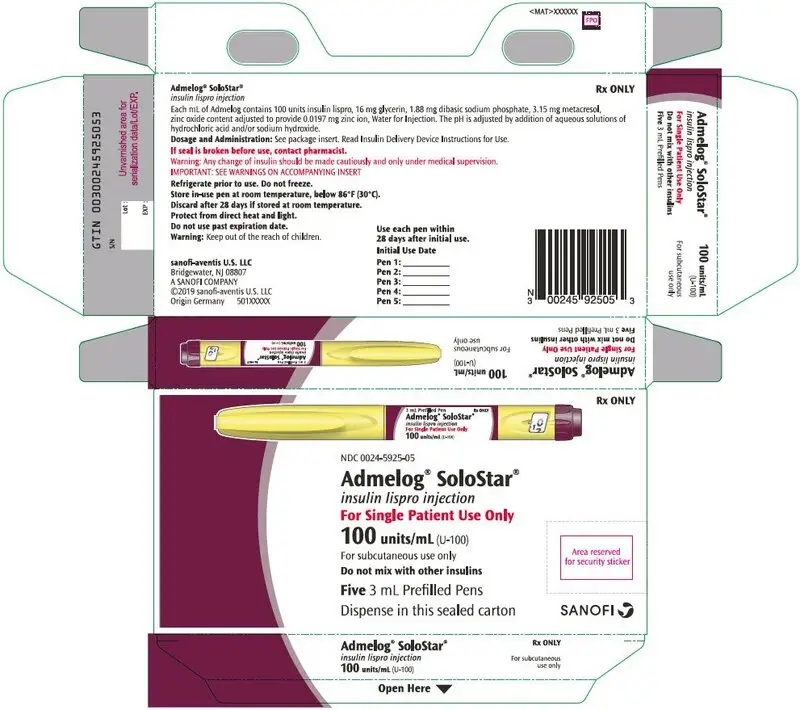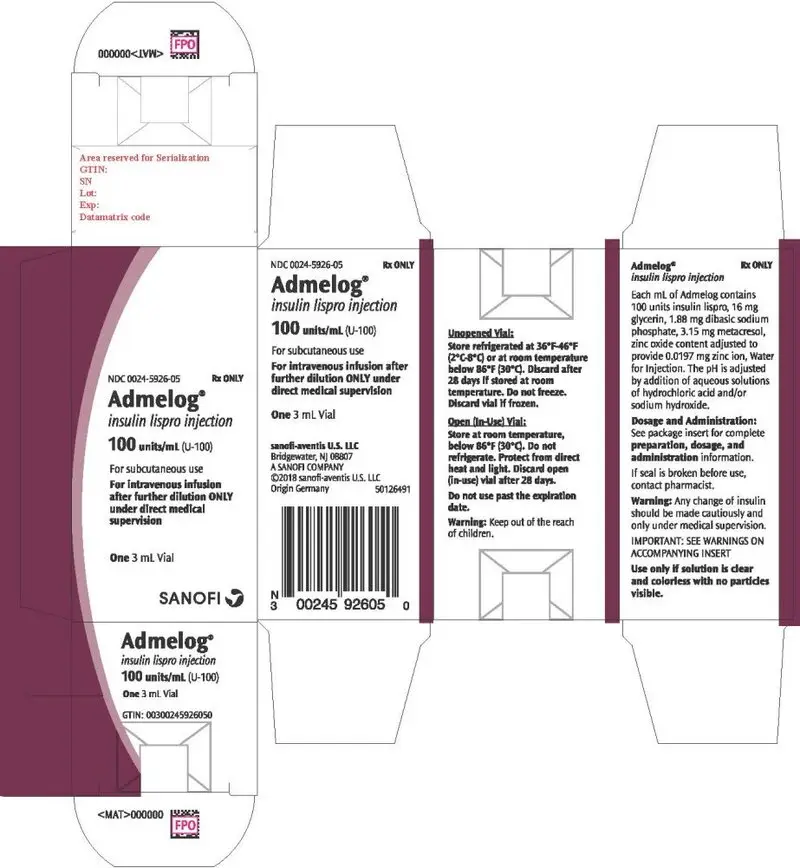Drug Detail:Admelog (Insulin lispro [ in-soo-lin-liss-pro ])
Drug Class: Insulin
Highlights of Prescribing Information
ADMELOG (insulin lispro injection), for subcutaneous or intravenous use
Initial U.S. Approval: 1996
Indications and Usage for Admelog
ADMELOG is a rapid-acting human insulin analog indicated to improve glycemic control in adults and pediatric patients 3 years and older with type 1 diabetes mellitus and adults with type 2 diabetes mellitus. (1)
Admelog Dosage and Administration
- See Full Prescribing Information for important administration instructions. (2.1, 2.2, 2.3, 2.4)
- Rotate injection sites to reduce risk of lipodystrophy and localized cutaneous amyloidosis. (2.2)
- Subcutaneous injection (2.2):
- Administer ADMELOG by subcutaneous injection in the abdominal wall, thigh, upper arm, or buttocks within 15 minutes before a meal or immediately after a meal.
- Rotate injection sites to reduce risk of lipodystrophy and localized cutaneous amyloidosis.
- Continuous subcutaneous infusion (Insulin Pump) (2.2):
- Administer ADMELOG by continuous subcutaneous infusion using an insulin pump in a region recommended in the instructions from the pump manufacturer.
- Rotate infusion sites to reduce risk of lipodystrophy and localized cutaneous amyloidosis.
- Intravenous Infusion: Administer ADMELOG by intravenous infusion ONLY after dilution and under medical supervision. (2.2)
- The dosage of ADMELOG must be individualized based on the route of administration and the individual's metabolic needs, blood glucose monitoring results and glycemic control goal. (2.3)
Dosage Forms and Strengths
Injection: 100 units/mL (U-100) is available as: (3)
- 10 mL multiple-dose vials
- 3 mL multiple-dose vials
- 3 mL single-patient-use SoloStar® prefilled pens
Contraindications
- Do not use during episodes of hypoglycemia. (4)
- Do not use in patients with hypersensitivity to insulin lispro or any of the excipients. (4)
Warnings and Precautions
- Never share an ADMELOG SoloStar disposable prefilled pen or syringe between patients, even if the needle is changed. (5.1)
- Hyperglycemia or Hypoglycemia with Changes in Insulin Regimen: Make changes to a patient's insulin regimen (e.g., insulin strength, manufacturer, type, injection site or method of administration) under close medical supervision with increased frequency of blood glucose monitoring. (5.2)
- Hypoglycemia: May be life-threatening. Monitor blood glucose and increase monitoring frequency with changes to insulin dosage, use of glucose lowering medications, meal pattern, physical activity; in patients with renal or hepatic impairment; and in patients with hypoglycemia unawareness. (5.3, 6, 7, 8.6, 8.7)
- Hypoglycemia Due to Medication Errors: Accidental mix-ups between insulin products can occur. Instruct patients to check insulin labels before injection. (5.4)
- Hypersensitivity Reactions: Severe, life-threatening, generalized allergic, including anaphylaxis can occur. Discontinue ADMELOG, monitor and treat if indicated. (5.5)
- Hypokalemia: May be life-threatening. Monitor potassium levels in patients at risk of hypokalemia and treat if indicated. (5.6)
- Fluid Retention and Heart Failure with Concomitant Use of Thiazolidinediones (TZDs): Observe for signs and symptoms of heart failure; consider dosage reduction or discontinuation if heart failure occurs. (5.7)
- Hyperglycemia and Ketoacidosis Due to Insulin Pump Device Malfunction: Monitor glucose and administer ADMELOG by subcutaneous injection if pump malfunction occurs. (5.8)
Adverse Reactions/Side Effects
Adverse reactions associated with ADMELOG include hypoglycemia, allergic reactions, injection site reactions, lipodystrophy, pruritus, and rash. (6.1)
To report SUSPECTED ADVERSE REACTIONS, contact sanofi-aventis at 1-800-633-1610 or FDA at 1-800-FDA-1088 or www.fda.gov/medwatch.
Drug Interactions
- Drugs that Affect Glucose Metabolism: Adjustment of insulin dosage may be needed. (7.1, 7.2, 7.3)
- Antiadrenergic Drugs (e.g., beta-blockers, clonidine, guanethidine, and reserpine): Signs and symptoms of hypoglycemia may be reduced or absent. (5.3, 7.4)
Use In Specific Populations
- Pediatrics: Safety and effectiveness not established in pediatric patients <3 years of age with type 1 diabetes mellitus or in pediatric patients with type 2 diabetes mellitus. (8.4)
See 17 for PATIENT COUNSELING INFORMATION and FDA-approved patient labeling.
Revised: 12/2020
Related/similar drugs
Mounjaro, metformin, Trulicity, Lantus, Victoza, Levemir, TresibaFull Prescribing Information
1. Indications and Usage for Admelog
ADMELOG is indicated to improve glycemic control in adults and pediatric patients 3 years and older with type 1 diabetes mellitus and adults with type 2 diabetes mellitus.
2. Admelog Dosage and Administration
2.1 Important Administration Instructions
- Always check insulin labels before administration [see Warnings and Precautions (5.4)].
- Inspect ADMELOG visually before use. It should appear clear and colorless. Do not use ADMELOG if particulate matter or coloration is seen.
- Use ADMELOG SoloStar prefilled pen with caution in patients with visual impairment who may rely on audible clicks to dial their dose.
- Do NOT mix ADMELOG with other insulins when administering using a continuous subcutaneous infusion pump.
2.3 Dosage Information
- Individualize and adjust the dosage of ADMELOG based on route of administration, the individual's metabolic needs, blood glucose monitoring results, and glycemic control goal.
- Dosage adjustments may be needed with changes in physical activity, changes in meal patterns (i.e., macronutrient content or timing of food intake), changes in renal or hepatic function, or during acute illness [see Warnings and Precautions (5.2, 5.3) and Use in Specific Populations (8.6, 8.7)].
- If changing patients from another insulin lispro product to ADMELOG, the dose of ADMELOG should be the same as the other insulin lispro product [see Warnings and Precautions (5.2)].
2.4 Dosage Adjustment Due to Drug Interactions
- Dosage adjustment may be needed when ADMELOG is coadministered with certain drugs [see Drug Interactions (7)].
- Dosage adjustment may be needed when switching from another insulin to ADMELOG [see Warnings and Precautions (5.2)].
- Do NOT mix ADMELOG with any other insulin.
3. Dosage Forms and Strengths
Insulin lispro injection 100 units per mL (U-100) is available as:
- 10 mL multiple-dose vials
- 3 mL multiple-dose vials
- 3 mL single patient use SoloStar prefilled pens
4. Contraindications
ADMELOG is contraindicated:
- during episodes of hypoglycemia.
- in patients who are hypersensitive to insulin lispro or to any of the excipients.
5. Warnings and Precautions
5.1 Never Share an ADMELOG SoloStar Pen or Syringe Between Patients
ADMELOG SoloStar prefilled pen must never be shared between patients, even if the needle is changed. Patients using ADMELOG vials must never share needles or syringes with another person. Sharing poses a risk for transmission of blood-borne pathogens.
5.2 Hyperglycemia or Hypoglycemia with Changes in Insulin Regimen
Changes in an insulin regimen (e.g., insulin strength, manufacturer, type, injection site or method of administration) may affect glycemic control and predispose to hypoglycemia [see Warnings and Precautions (5.3)] or hyperglycemia. Repeated insulin injections into areas of lipodystrophy or localized cutaneous amyloidosis have been reported to result in hyperglycemia; and a sudden change in the injection site (to unaffected area) has been reported to result in hypoglycemia [see Adverse Reactions (6)].
Make any changes to a patient's insulin regimen under close medical supervision with increased frequency of blood glucose monitoring. Advise patients who have repeatedly injected into areas of lipodystrophy or localized cutaneous amyloidosis to change the injection site to unaffected areas and closely monitor for hypoglycemia. For patients with type 2 diabetes, dosage adjustments of concomitant anti-diabetic products may be needed.
5.3 Hypoglycemia
Hypoglycemia is the most common adverse reaction associated with insulins, including ADMELOG.
Severe hypoglycemia can cause seizures, may be life-threatening, or cause death. Hypoglycemia can impair concentration ability and reaction time; this may place an individual and others at risk in situations where these abilities are important (e.g., driving or operating other machinery).
Hypoglycemia can happen suddenly, and symptoms may differ in each individual and change over time in the same individual. Symptomatic awareness of hypoglycemia may be less pronounced in patients with longstanding diabetes, in patients with diabetic nerve disease, in patients using medications that block the sympathetic nervous system (e.g., beta-blockers) [see Drug Interactions (7)], or in patients who experience recurrent hypoglycemia.
5.4 Hypoglycemia Due to Medication Errors
Accidental mix-ups between basal insulin products and other insulins, particularly rapid-acting insulins, have been reported. To avoid medication errors between ADMELOG and other insulins, instruct patients to always check the insulin label before each injection.
5.5 Hypersensitivity Reactions
Severe, life-threatening, generalized allergic reactions, including anaphylaxis, can occur with insulin products, including ADMELOG. If hypersensitivity reactions occur, discontinue ADMELOG; treat per standard of care and monitor until symptoms and signs resolve [see Adverse Reactions (6.1)]. ADMELOG is contraindicated in patients who have had hypersensitivity reactions to insulin lispro or any of the excipients [see Contraindications (4)].
5.6 Hypokalemia
All insulin products, including ADMELOG, cause a shift in potassium from the extracellular to intracellular space, possibly leading to hypokalemia. Untreated hypokalemia may cause respiratory paralysis, ventricular arrhythmia, and death. Monitor potassium levels in patients at risk for hypokalemia if indicated (e.g., patients using potassium-lowering medications, patients taking medications sensitive to serum potassium concentrations).
5.7 Fluid Retention and Heart Failure with Concomitant Use of PPAR-gamma Agonists
Thiazolidinediones (TZDs), which are peroxisome proliferator-activated receptor (PPAR)-gamma agonists, can cause dose-related fluid retention, particularly when used in combination with insulin. Fluid retention may lead to or exacerbate heart failure. Patients treated with insulin, including ADMELOG, and a PPAR-gamma agonist should be observed for signs and symptoms of heart failure. If heart failure develops, it should be managed according to current standards of care, and discontinuation or dose reduction of the PPAR-gamma agonist must be considered.
5.8 Hyperglycemia and Ketoacidosis Due to Insulin Pump Device Malfunction
Malfunction of the insulin pump or insulin infusion set or insulin degradation can rapidly lead to hyperglycemia and ketoacidosis. Prompt identification and correction of the cause of hyperglycemia or ketosis is necessary. Interim subcutaneous injections with ADMELOG may be required. Patients using continuous subcutaneous insulin infusion pump therapy must be trained to administer insulin by injection and have alternate insulin therapy available in case of pump failure [see How Supplied/Storage and Handling (16.2) and Patient Counseling Information (17)].
6. Adverse Reactions/Side Effects
The following adverse reactions are also discussed elsewhere:
- Hypoglycemia [see Warnings and Precautions (5.3)]
- Hypersensitivity and allergic reactions [see Warnings and Precautions (5.5)]
- Hypokalemia [see Warnings and Precautions (5.6)]
6.1 Clinical Trials Experience
Because clinical trials are conducted under widely varying conditions, adverse reaction rates observed in the clinical trials of a drug cannot be directly compared to rates in the clinical trials of another drug and may not reflect the rates observed in practice.
Two clinical trials with ADMELOG were conducted: one in patients with type 1 diabetes and one in patients with type 2 diabetes [see Clinical Studies (14)].
The data in Table 1 reflect the exposure of 252 patients with type 1 diabetes to ADMELOG with mean exposure duration of 49 weeks. The type 1 diabetes population had the following characteristics: Mean age was 43 years and mean duration of diabetes was 20 years. Fifty-nine percent were male, 80% were White, 6% were Black or African American and 7% were Hispanic. At baseline, the mean eGFR was 90 mL/min/1.73 m2 and 49% of patients had eGFR ≥90 mL/min/1.73 m2. The mean BMI was 26 kg/m2. The mean HbA1c at baseline was 8.07%.
Two hundred fifty-three patients with type 2 diabetes were exposed to ADMELOG with mean exposure duration of 25 weeks. The type 2 diabetes population had the following characteristics: Mean age was 62 years and mean duration of diabetes was 17 years. Fifty-four percent were male, 90% were White, 6% were Black or African American and 17% were Hispanic. At baseline, the mean eGFR was 77 mL/min/1.73 m2 and 27% of patients had eGFR ≥90 mL/min/1.73 m2. The mean BMI was 32 kg/m2. The mean HbA1c at baseline was 7.99%.
Common adverse reactions were defined as reactions occurring in ≥5% of the population studied.
Common adverse reactions (other than hypoglycemia) during a clinical trial in patients with type 1 diabetes mellitus are listed in Table 1. In a 26-week clinical trial in patients with type 2 diabetes mellitus, no adverse reactions (other than hypoglycemia) occurring in ≥5% of ADMELOG-treated patients (n=253) were observed.
| ADMELOG + Insulin Glargine (100 units/mL), % (n=252) |
|
|---|---|
| Nasopharyngitis | 13.1% |
| Upper respiratory tract infection | 6.0% |
6.2 Immunogenicity
Consistent with the potentially immunogenic properties of protein and peptide pharmaceuticals, patients treated with ADMELOG may develop anti-insulin antibodies. The detection of antibody formation is highly dependent on the sensitivity and specificity of the assay and may be influenced by several factors such as assay methodology, sample handling, timing of sample collection, concomitant medication, and underlying disease. For these reasons, the incidence of antibodies to ADMELOG in the studies described below cannot be directly compared with the incidence of antibodies in other studies or to other products.
In a 52-week study of ADMELOG in type 1 diabetes patients, 49.4% were positive at baseline and 22.6% had treatment-emergent ADA (i.e., either new ADA, or increase in titer of at least 4-fold).
In a 26-week study of ADMELOG in type 2 diabetes patients, 26.4% were positive at baseline and 18.8% had treatment-emergent ADA (i.e., either new ADA, or increase in titer of at least 4-fold).
6.3 Postmarketing Experience
The following additional adverse reactions have been identified during postapproval use of another insulin lispro product, 100 units/mL. Because these reactions are reported voluntarily from a population of uncertain size, it is not always possible to reliably estimate their frequency or establish a causal relationship to drug exposure.
Medication errors in which other insulins have been accidentally substituted for another insulin lispro product, 100 units/mL, have been identified during postapproval use [see Patient Counseling Information (17)].
Localized cutaneous amyloidosis at the injection site has occurred. Hyperglycemia has been reported with repeated insulin injections into areas of localized cutaneous amyloidosis; hypoglycemia has been reported with a sudden change to an unaffected injection site.
7. Drug Interactions
7.1 Drugs that May Increase the Risk of Hypoglycemia
The risk of hypoglycemia associated with ADMELOG use may be increased when coadministered with antidiabetic agents, salicylates, sulfonamide antibiotics, monoamine oxidase inhibitors, fluoxetine, pramlintide, disopyramide, fibrates, pentoxifylline, ACE inhibitors, angiotensin II receptor blocking agents, and somatostatin analogs (e.g., octreotide). Dose adjustment and increased frequency of glucose monitoring may be required when ADMELOG is coadministered with these drugs.
7.2 Drugs that May Decrease the Blood Glucose Lowering Effect of ADMELOG
The glucose lowering effect of ADMELOG may be decreased when coadministered with corticosteroids, isoniazid, niacin, estrogens, oral contraceptives, phenothiazines, danazol, diuretics, sympathomimetic agents (e.g., epinephrine, albuterol, terbutaline), somatropin, atypical antipsychotics, glucagon, protease inhibitors, and thyroid hormones. Dose adjustment and increased frequency of glucose monitoring may be required when ADMELOG is coadministered with these drugs.
7.3 Drugs that May Increase or Decrease the Blood Glucose Lowering Effect of ADMELOG
The glucose lowering effect of ADMELOG may be increased or decreased when coadministered with beta-blockers, clonidine, lithium salts, and alcohol. Pentamidine may cause hypoglycemia, which may sometimes be followed by hyperglycemia. Dose adjustment and increased frequency of glucose monitoring may be required when ADMELOG is coadministered with these drugs.
8. Use In Specific Populations
8.4 Pediatric Use
The safety and effectiveness of ADMELOG have been established in pediatric patients with type 1 diabetes mellitus who are 3 years of age and older. Use of ADMELOG in these age groups is supported by evidence from adequate and well-controlled studies of ADMELOG and another insulin lispro product, 100 units/ml, in adults with additional data from adequate and well-controlled studies of pediatric patients using another insulin lispro product, 100 units/ml [see Clinical Studies (14)].
The safety and effectiveness of ADMELOG have not been established in pediatric patients younger than 3 years of age with type 1 diabetes mellitus or in pediatric patients with type 2 diabetes mellitus.
The dosage of ADMELOG must be individualized in pediatric patients based on metabolic needs and results of frequent monitoring of blood glucose.
8.5 Geriatric Use
Of the total number of subjects (n=2,834) in eight clinical studies of another insulin lispro product, 100 units/mL, 12% (n=338) were 65 years of age or over. The majority of these had type 2 diabetes. HbA1c values and hypoglycemia rates did not differ by age.
Of the total number of subjects (n=1,011) in clinical studies of patients treated with ADMELOG or another insulin lispro product, 100 units/mL, 26.5% (n=268) were 65 years of age or over. The majority of these had type 2 diabetes. HbA1c values and hypoglycemia rates did not differ by age.
Pharmacokinetic/pharmacodynamic studies to assess the effect of age on the onset of ADMELOG action have not been performed.
10. Overdosage
Excess insulin administration may cause hypoglycemia and hypokalemia. Mild episodes of hypoglycemia usually can be treated with oral glucose. Adjustments in drug dosage, meal patterns, or exercise may be needed. More severe episodes with coma, seizure, or neurologic impairment may be treated with intramuscular/subcutaneous glucagon or concentrated intravenous glucose. Sustained carbohydrate intake and observation may be necessary because hypoglycemia may recur after apparent clinical recovery. Hypokalemia must be corrected appropriately.
11. Admelog Description
ADMELOG (insulin lispro injection) is a rapid-acting human insulin analog used to lower blood glucose. Insulin lispro is produced by recombinant DNA technology utilizing a non-pathogenic laboratory strain of Escherichia coli. Insulin lispro differs from human insulin in that the amino acid proline at position B28 is replaced by lysine and the lysine in position B29 is replaced by proline. Chemically, it is Lys(B28), Pro(B29) human insulin analog and has the empirical formula C257H383N65O77S6 and a molecular weight of 5808, both identical to that of human insulin.
ADMELOG has the following primary structure:

ADMELOG is a sterile, aqueous, clear, and colorless solution. Each milliliter of ADMELOG contains insulin lispro 100 units, 16 mg glycerin, 1.88 mg dibasic sodium phosphate, 3.15 mg metacresol, zinc oxide content adjusted to provide 0.0197 mg zinc ion, and Water for Injection. Insulin lispro has a pH of 7.0 to 7.8. The pH is adjusted by addition of aqueous solutions of hydrochloric acid and/or sodium hydroxide.
12. Admelog - Clinical Pharmacology
12.1 Mechanism of Action
Regulation of glucose metabolism is the primary activity of insulins and insulin analogs, including insulin lispro products. Insulins lower blood glucose by stimulating peripheral glucose uptake by skeletal muscle and fat, and by inhibiting hepatic glucose production. Insulins inhibit lipolysis and proteolysis and enhance protein synthesis.
12.2 Pharmacodynamics
12.3 Pharmacokinetics
13. Nonclinical Toxicology
13.1 Carcinogenesis, Mutagenesis, Impairment of Fertility
Standard 2-year carcinogenicity studies in animals have not been performed. In Fischer 344 rats, a 12-month repeat-dose toxicity study was conducted with insulin lispro at subcutaneous doses of 20 and 200 units/kg/day (approximately 3 and 32 times the human subcutaneous dose of 1 unit/kg/day, based on units/body surface area). Insulin lispro did not produce important target organ toxicity including mammary tumors at any dose.
Insulin lispro was not mutagenic in the following genetic toxicity assays: bacterial mutation, unscheduled DNA synthesis, mouse lymphoma, chromosomal aberration, and micronucleus assays.
Male fertility was not compromised when male rats given subcutaneous insulin lispro injections of 5 and 20 units/kg/day (0.8 and 3 times the human subcutaneous dose of 1 unit/kg/day, based on units/body surface area) for 6 months were mated with untreated female rats. In a combined fertility, perinatal, and postnatal study in male and female rats given 1, 5, and 20 units/kg/day subcutaneously (0.16, 0.8, and 3 times the human subcutaneous dose of 1 unit/kg/day, based on units/body surface area), mating and fertility were not adversely affected in either gender at any dose.
14. Clinical Studies
14.2 Type 1 Diabetes Mellitus – Subcutaneous Injection
ADMELOG: Study in Adult Patients
A 26-week open-label, active-controlled study (NCT02273180) evaluated the glucose lowering effect of ADMELOG plus insulin glargine, 100 units/mL, compared to that of Comparator (another insulin lispro product, 100 units/mL, or a non–U.S.-approved insulin lispro, 100 units/mL), plus insulin glargine, 100 units/mL. A total of 507 patients with type 1 diabetes mellitus treated with insulin glargine 100 units/mL and rapid-acting mealtime insulin analogs participated in the study. Patients were randomized to ADMELOG (n=253) or Comparator (n=254). ADMELOG or Comparator was administered by subcutaneous injection immediately prior to meals.
The mean age of these subjects was 43 years, and 59.6% were male. The population was 82.1% White, 4.7% Black or African American and 5.3% were Hispanic. The population had type 1 diabetes mellitus for a mean duration of 19 years. The mean eGFR was 90.6 mL/min/1.73 m2 and 48.7% of patients had GFR ≥90 mL/min/1.73 m2. The mean BMI was approximately 26 kg/m2. At baseline, 60.6%, 37.5% and 2.0% of the patients were using other insulin lispro products, 100 units/mL, insulin aspart, 100 units/mL, or both, respectively.
At week 26, treatment with ADMELOG provided a mean reduction in HbA1c that was non-inferior to that achieved with the Comparator (see Table 3).
| Treatment Duration Treatment in Combination with: | 26 Weeks Insulin Glargine |
|
|---|---|---|
| ADMELOG | Comparator | |
|
||
| N* | 253 | 254 |
| HbA1c (%) | ||
| Baseline (mean) | 8.08 | 7.99 |
| Adjusted mean change from baseline† | -0.40 | -0.46 |
| Adjusted mean difference‡
(95% CI) | 0.06 (-0.086 to 0.201) |
|
Another Insulin Lispro Product, 100 units/mL: Study in Adult and Pediatric Patients 12 Years of Age and Older
A 12-month, randomized, parallel, open-label, active-controlled study was conducted in 167 patients with type 1 diabetes to assess the safety and efficacy of another insulin lispro product, 100 units/mL (n=81), compared with regular human insulin, 100 units/mL (n=86). This other insulin lispro product was administered by subcutaneous injection immediately prior to meals and regular human insulin was administered 30 to 45 minutes before meals. Human insulin extended zinc suspension was administered once or twice daily as the basal insulin. There was a 2 to 4-week run-in period with regular human insulin and human insulin extended zinc suspension before randomization.
The mean age of these subjects was 31 years (range 12 to 70 years), and 47% were male. The population was 97% White.
| Treatment Duration Treatment in Combination with: | 12 Months Human Insulin Extended Zinc |
|
|---|---|---|
| Another Insulin Lispro Product | Regular Human Insulin | |
|
||
| N | 81 | 86 |
| Baseline HbA1c (%)* | 8.2 ± 1.4 | 8.3 ± 1.7 |
| Change from baseline HbA1c (%)* | -0.1 ± 0.9 | 0.1 ± 1.1 |
| Treatment difference in HbA1c mean (95% confidence interval) | 0.4 (0.0; 0.8) | |
Another Insulin Lispro Product, 100 units/mL: Studies in Pediatric Patients 3 Years of Age and Older
An 8-month, crossover study of pediatric patients with type 1 diabetes (n=463), aged 9 to 19 years, compared two subcutaneous multiple-dose treatment regimens: another insulin lispro product, 100 units/mL, or regular human insulin, 100 units/mL, both administered with NPH human insulin isophane suspension as the basal insulin. Insulin lispro achieved glycemic control comparable to regular human insulin, as measured by HbA1c (see Table 5).
| Baseline | Another Insulin Lispro Product + NPH | Regular Human Insulin + NPH | |
|---|---|---|---|
|
|||
| HbA1c (%)* | 8.6 ± 1.5 | 8.7 ± 1.5 | 8.7 ± 1.6 |
| Change from baseline HbA1c (%)* | - | 0.1 ± 1.1 | 0.1 ± 1.3 |
In a 9-month, crossover study of pediatric patients with type 1 diabetes mellitus (n=60), aged 3 to 11 years, compared three subcutaneous injection regimens: another insulin lispro product, 100 units/mL, administered immediately before meals, this same insulin lispro product, 100 units/mL, administered immediately after meals and regular human insulin, 100 units/mL administered 30 minutes before meals resulted in similar glycemic control, as measured by HbA1c, regardless of treatment group.
14.3 Type 1 Diabetes Mellitus – Continuous Subcutaneous Infusion
Another Insulin Lispro Product, 100 units/mL: Study in Pediatric Patients 4 Years of Age and Older
A randomized, 16-week, open-label, parallel design, study of pediatric patients with type 1 diabetes mellitus (n=298), aged 4 to 18 years, compared two subcutaneous infusion regimens administered via an external insulin pump: insulin aspart, 100 units/mL (n=198), or another insulin lispro product, 100 units/mL (n=100). These two treatments resulted in comparable changes from baseline in HbA1c after 16 weeks of treatment (see Table 6).
| Treatment duration | 16 Weeks | |
|---|---|---|
| Another Insulin Lispro Product | Insulin Aspart | |
|
||
| N | 100 | 198 |
| Baseline HbA1c (%)* | 8.2 ± 0.8 | 8.0 ± 0.9 |
| Change from Baseline HbA1c (%) | -0.1 ± 0.7 | -0.1 ± 0.8 |
| Treatment Difference in HbA1c, Mean (95% confidence interval) | 0.1 (-0.3, 0.1) | |
14.4 Type 2 Diabetes Mellitus
ADMELOG: Study in Adult Patients
A 26-week open-label, active-controlled study (NCT02294474) evaluated the glucose lowering effect of ADMELOG plus insulin glargine, 100 units/mL, compared to that of Comparator (another insulin lispro product, 100 units/mL, or a non–U.S.-approved insulin lispro, 100 units/mL) plus insulin glargine, 100 units/mL. A total of 505 patients with type 2 diabetes mellitus treated with insulin glargine, 100 units/mL, and rapid-acting mealtime insulin analogs participated in the study. Patients were randomized to ADMELOG, 100 units/mL (n=253) or Comparator (n=252). ADMELOG or Comparator, was administered by subcutaneous injection immediately prior to meals.
The mean age of these subjects was 62.5 years, and 53.1% were male. The population was 88.3% White, 6.1% Black or African American and 17.8% were Hispanic. The population had type 2 diabetes mellitus for a mean duration of 17 years. The mean eGFR was 77.9 mL/min/1.73 m2 and 26.9% of patients had GFR >90 mL/min/1.73 m2. The mean BMI was approximately 32.2 kg/m2. At baseline, 51.4%, 48.2%, and 0.4% of the patients were using other insulin lispro products, 100 units/mL, insulin aspart, 100 units/mL, or both, respectively.
At week 26, treatment with ADMELOG provided a mean reduction in HbA1c that was non-inferior to that achieved with the Comparator (see Table 7).
| Treatment Duration Treatment in Combination with: | 26 Weeks Insulin Glargine |
|
|---|---|---|
|
||
| ADMELOG | Comparator | |
| N* | 253 | 252 |
| HbA1c (%) | ||
| Baseline (mean) | 8.00 | 8.03 |
| Adjusted mean change from baseline† | -0.86 | -0.80 |
| Adjusted mean difference‡
(95% CI) | -0.06 (-0.209 to 0.091) |
|
Another Insulin Lispro Product, 100 units/mL: Study in Adult Patients
A 6-month randomized, crossover, open-label, active-controlled study was conducted in 722 patients with type 2 diabetes mellitus treated with insulin to assess the safety and efficacy of another insulin lispro product, 100 units/mL, for 3 months followed by regular human insulin, 100 units/mL, for 3 months or the reverse sequence. This other insulin lispro product was administered by subcutaneous injection immediately before meals and regular human insulin was administered 30 to 45 minutes before meals. NPH human insulin isophane suspension or human insulin extended zinc suspension was administered once or twice daily as the basal insulin. All patients participated in a 2 to 4-week run-in period with regular human insulin and NPH human insulin isophane suspension or human insulin extended zinc suspension.
Most of the patients were Caucasian (88%), and the numbers of men and women in each group were approximately equal. The mean age was 58.6 years (range 23.8 to 85 years). The average body mass index (BMI) was 28.2 kg/m2. During the study, the majority of patients used NPH human insulin isophane suspension (84%) compared with human insulin extended zinc suspension (16%) as their basal insulin. The reductions from baseline in HbA1c were similar between the two treatments from the combined groups (see Table 8).
| Treatment Duration | 3 Months | ||
|---|---|---|---|
| Baseline | Another Insulin Lispro Product + Basal | Regular Human Insulin + Basal | |
|
|||
| HbA1c (%)* | 8.9 ± 1.7 | 8.2 ± 1.3 | 8.2 ± 1.4 |
| Change from baseline HbA1c (%)* | - | -0.7 ± 1.4 | -0.7 ± 1.3 |
16. How is Admelog supplied
16.1 How Supplied
ADMELOG: Insulin Lispro Injection 100 units per mL (U-100) is available as:
| Dosage Unit | Package Size | NDC # |
|---|---|---|
| 10 mL multiple-dose vials | Carton of 1 | 0024-5924-10 |
| 3 mL multiple-dose vials | Carton of 1 | 0024-5926-05 |
| 3 mL single patient use SoloStar prefilled pen | Carton of 5 | 0024-5925-05 |
Each prefilled SoloStar pen is for use by a single patient. ADMELOG SoloStar pen must never be shared between patients, even if the needle is changed. Patients using ADMELOG vials must never share needles or syringes with another person.
The ADMELOG SoloStar prefilled pen dials in 1-unit increments.
16.2 Storage and Handling
Dispense in the original sealed carton with the enclosed Instructions for Use.
Do not use after the expiration date.
Not in-use (unopened) ADMELOG should be stored in a refrigerator (36°F-46°F [2°C-8°C]), but not in the freezer. Do not use ADMELOG if it has been frozen.
In-use (opened) ADMELOG vials and ADMELOG SoloStar pens should be stored at room temperature (below 86°F [30°C]) and must be used within 28 days or be discarded, even if they still contain ADMELOG. Protect from direct heat and light.
See table below:
| ADMELOG | Not In-Use (Unopened) Room Temperature (Below 86°F [30°C]) | Not In-Use (Unopened) Refrigerated (36°F-46°F [2°C-8°C]) | In-Use (Opened) Room Temperature (Below 86°F [30°C]) |
|---|---|---|---|
| 10 mL multiple-dose vial | 28 days | Until expiration date | 28 days refrigerated/room temperature |
| 3 mL multiple-dose vial | 28 days | Until expiration date | 28 days refrigerated/room temperature |
| 3 mL single-patient-use SoloStar prefilled pen | 28 days | Until expiration date | 28 days Do not refrigerate. |
17. Patient Counseling Information
Advise the patient to read the FDA-approved patient labeling (Patient Information and Instructions for Use).
Instructions for Use
ADMELOG® (ad-mah-log)
(insulin lispro injection) for subcutaneous use
10 mL or 3 mL Vial (100 Units/mL, U-100)
Read these Instructions for Use before you start taking ADMELOG and each time you get a new ADMELOG vial. There may be new information. This information does not take the place of talking to your healthcare provider about your medical condition or your treatment.
Do not share your ADMELOG syringes with other people, even if the needle has been changed. You may give other people a serious infection, or get a serious infection from them.
Supplies needed to give your injection
- an ADMELOG 10 mL or 3 mL vial
- a U-100 insulin syringe and needle
- 2 alcohol swabs
- 1 sharps container for throwing away used needles and syringes. See "Disposing of used needles and syringes" at the end of these instructions.
Preparing your ADMELOG dose
- Wash your hands with soap and water or with alcohol.
- Check the ADMELOG label to make sure you are taking the right type of insulin. This is especially important if you use more than 1 type of insulin.
- Check the insulin to make sure it is clear and colorless. Do not use ADMELOG if it is colored or cloudy, or if you see particles in the solution.
- Do not use ADMELOG after the expiration date stamped on the label or 28 days after you first use it.
- Always use a syringe that is marked for U-100 insulin. If you use a syringe other than a U-100 insulin syringe, you may get the wrong dose of insulin.
- Always use a new syringe or needle for each injection to help ensure sterility and prevent blocked needles. Do not reuse or share your syringes or needles with other people. You may give other people a serious infection or get a serious infection from them.
Step 1:
If you are using a new vial, remove the protective cap. Do not remove the stopper.

Step 2:
Wipe the top of the vial with an alcohol swab. You do not have to shake the vial of ADMELOG before use.

Step 3:
Draw air into the syringe equal to your insulin dose. Put the needle through the rubber top of the vial and push the plunger to inject the air into the vial.

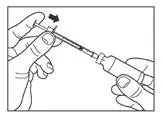
Step 4:
Leave the syringe in the vial and turn both upside down. Hold the syringe and vial firmly in one hand. Make sure the tip of the needle is in the insulin. With your free hand, pull the plunger to withdraw the correct dose into the syringe.
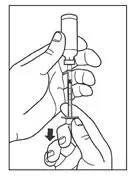
Step 5:
Before you take the needle out of the vial, check the syringe for air bubbles. If bubbles are in the syringe, hold the syringe straight up and tap the side of the syringe until the bubbles float to the top. Push the bubbles out with the plunger and draw insulin back in until you have the correct dose.
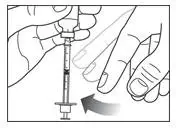
Step 6:
Remove the needle from the vial. Do not let the needle touch anything. You are now ready to inject.
Giving your ADMELOG injection with a syringe
- Inject your insulin exactly as your healthcare provider has shown you.
- ADMELOG starts acting fast, so give your injection within 15 minutes before or right after you eat a meal.
Step 7:
- Choose your injection site: ADMELOG is injected under the skin (subcutaneously) of your upper arms, thighs, buttocks, or stomach area (abdomen).
- Change (rotate) your injection sites within the area you choose for each dose to reduce your risk of getting lipodystrophy (pits in the skin or thickened skin) and localized cutaneous amyloidosis (skin with lumps) at the injection sites.
- Do not inject where the skin has pits, is thickened, or has lumps.
- Do not inject where the skin is tender, bruised, scaly or hard, or into scars or damaged skin.

- Wipe the skin with an alcohol swab to clean the injection site. Let the injection site dry before you inject your dose.

Step 8:
- Pinch the skin.
- Insert the needle in the way your healthcare provider showed you.
- Release the skin.
- Slowly push in the plunger of the syringe all the way, making sure you have injected all the insulin.
- Leave the needle in the skin for about 10 seconds.
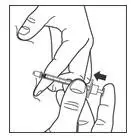
Step 9:
- Pull the needle straight out of your skin.
- Gently press the injection site for several seconds. Do not rub the area.
- Do not recap the used needle. Recapping the needle can lead to a needle-stick injury.
Giving your ADMELOG using an insulin pump
- ADMELOG should be inserted into an area of your body recommended in the instructions that come with your insulin pump.
- Change your insertion site every 3 days.
- Change (rotate) your insertion sites within the area you choose for each insertion to reduce your risk of getting lipodystrophy (pits in skin or thickened skin) and localized cutaneous amyloidosis (skin with lumps) at the injection sites. Do not insert into the exact same spot for each injection. Do not insert where the skin has pits, is thickened, or has lumps. Do not insert where the skin is tender, bruised, scaly or hard, or into scars or damaged skin.
- Change the insulin in the reservoir at least every 7 days, even if you have not used all of the insulin.
- Do not dilute or mix ADMELOG with any other type of insulin in your insulin pump.
- See your insulin pump manual for instructions or talk to your healthcare provider.
Disposing of used needles and syringes
- Put your used needles and syringes in a FDA-cleared sharps disposal container right away after use. Do not throw away (dispose of) loose needles and syringes in your household trash.
- If you do not have a FDA-cleared sharps container, you may use a household container that is:
- made of a heavy-duty plastic,
- can be closed with a tight-fitting, puncture-resistant lid, without sharps being able to come out,
- upright and stable during use,
- leak resistant, and
- properly labeled to warn of hazardous waste inside the container.
- When your sharps disposal container is almost full, you will need to follow your community guidelines for the right way to dispose of your sharps disposal container. There may be state or local laws about how you should throw away used needles and syringes. For more information about safe sharps disposal, and for specific information about sharps disposal in the state that you live in, go to the FDA's website at: http://www.fda.gov/safesharpsdisposal.
- Do not dispose of your used sharps disposal container in your household trash unless your community guidelines permit this. Do not recycle your used sharps disposal container.
How should I store ADMELOG?
Unopened (not in-use) ADMELOG vials
- Store unused ADMELOG vials in the refrigerator from 36°F to 46°F (2°C to 8°C).
- Do not freeze ADMELOG.
- Keep ADMELOG away from direct heat and light.
- If a vial has been frozen or overheated, throw it away.
- Unopened vials can be used until the expiration date on the carton and label if they have been stored in the refrigerator.
- Unopened vials should be thrown away after 28 days if they are stored at room temperature.
After ADMELOG vials have been opened (in-use)
- Store in-use (opened) ADMELOG vials in a refrigerator from 36°F to 46°F (2°C to 8°C) or at room temperature below 86°F (30°C) for up to 28 days.
- Do not freeze ADMELOG.
- Keep ADMELOG out of direct heat and light.
- If a vial has been frozen, throw it away.
- The ADMELOG vial you are using should be thrown away after 28 days, even if it still has insulin left in it.
This Instructions for Use has been approved by the U.S. Food and Drug Administration.
sanofi-aventis U.S. LLC, Bridgewater, NJ 08807, A SANOFI COMPANY
ADMELOG is a registered trademark of sanofi-aventis U.S. LLC.
Revised: November 2019
Instructions for Use ADMELOG® SoloStar® (ad-mah-log)(insulin lispro injection) for subcutaneous use3 mL single-patient-use prefilled pen (100 Units/mL, U-100)
Read this first
Do not share your ADMELOG SoloStar pen with other people, even if the needle has been changed. You may give other people a serious infection, or get a serious infection from them.
People who are blind or have vision problems should not use ADMELOG SoloStar prefilled pen without help from a person trained to use ADMELOG SoloStar prefilled pen.
ADMELOG SoloStar is a disposable prefilled pen used to inject ADMELOG. Each ADMELOG SoloStar has 300 units of insulin which can be used for multiple injections. You can select doses from 1 to 80 units in steps of 1 unit. The pen plunger moves with each dose. The plunger will only move to the end of the cartridge when 300 units of insulin have been given.
Important information
- Do not use your pen if it is damaged or if you are not sure that it is working properly.
- Do not use a syringe to remove insulin from your pen.
- Do not reuse needles. If you do, you might get the wrong dose of ADMELOG and/or increase the chance of getting an infection.
- Always perform a safety test (see Step 3).
- Always carry a spare pen and spare needles in case they got lost or stop working.
- Change (rotate) your injection sites within the area you choose for each dose (see "Places to inject").
Learn to inject
- Talk with your healthcare provider about how to inject before using your pen.
- Ask for help if you have problems handling the pen, for example if you have problems with your sight.
- Read all of these instructions before using your pen. If you do not follow all of these instructions, you may get too much or too little insulin.
Need help?
If you have any questions about your pen or about diabetes, ask your healthcare provider, or go to www.Admelog.com or call sanofi-aventis at 1-800-633-1610.
Extra items you will need:
- a new sterile needle (see Step 2).
- an alcohol swab.
- a puncture-resistant container for used needles and pens. (See "Throwing your pen away").
- Inject your insulin exactly as your healthcare provider has shown you.
- Inject your insulin under the skin (subcutaneously) of your upper legs (thighs), upper arms, or stomach area (abdomen).
- Change (rotate) your injection sites within the area you choose for each dose to reduce your risk of getting lipodystrophy (pits in skin or thickened skin) and localized cutaneous amyloidosis (skin with lumps) at the injection sites.
- Do not inject where the skin has pits, is thickened, or has lumps.
- Do not inject where the skin is tender, bruised, scaly or hard, or into scars or damaged skin.

Get to know your pen

Step 1: Check your pen
Take a new pen out of the refrigerator at least 1 hour before you inject. Cold insulin is more painful to inject.
1A Check the name and expiration date on the label of your pen.
- Make sure you have the correct insulin.
- Do not use your pen after the expiration date.
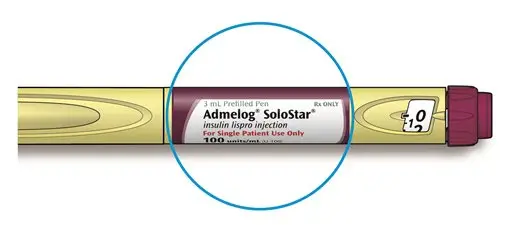
1B Pull off the pen cap.
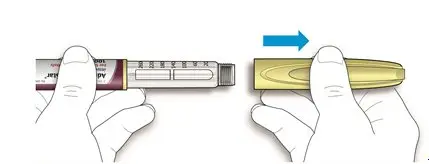
1C Check that the insulin is clear.
- Do not use the pen if the insulin looks cloudy, colored or contains particles.
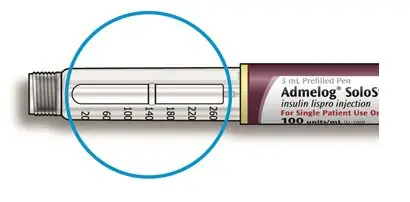
1D Wipe the rubber seal with an alcohol swab.

If you have other injector pens:
- Making sure you have the correct medicine is especially important if you have other injector pens.
- Do not reuse needles. Always use a new sterile needle for each injection. This helps stop blocked needles, contamination, and infection.
- Only use needles1 that are compatible for use with ADMELOG SoloStar, e.g. needles from BD (such as BD Ultra-Fine®), Ypsomed (such as Clickfine®), Owen Mumford (such as Unifine® Pentips®).
2A Take a new needle and peel off the protective seal.

2B Keep the needle straight and screw it onto the pen until fixed. Do not over-tighten.
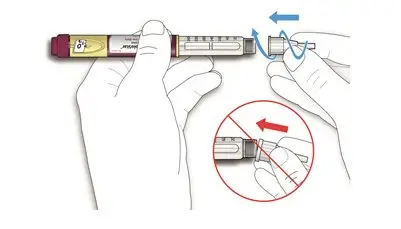
2C Pull off the outer needle cap. Keep this for later.
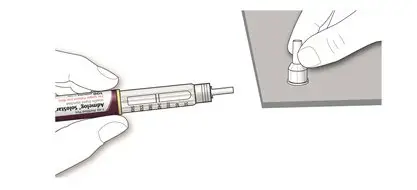
2D Pull off the inner needle cap and throw away.
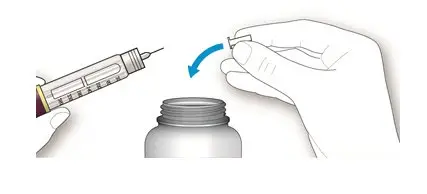
Handling needles:
- Take care when handling needles to prevent needle-stick injury and cross-infection.
Always do a safety test before each injection to:
- Check your pen and the needle to make sure they are working properly.
- Make sure that you get the correct insulin dose.
3A Select 2 units by turning the dose selector until the dose pointer is at the 2 mark.

3B Press the injection button all the way in.
- When insulin comes out of the needle tip, your pen is working correctly.

If no insulin appears:
- You may need to repeat this step up to 3 times before seeing insulin.
- If no insulin comes out after the third time, the needle may be blocked. If this happens:
- –
- change the needle (see Step 6 and Step 2),
- –
- then repeat the safety test (Step 3).
- Do not use your pen if there is still no insulin coming out of the needle tip. Use a new pen.
- Do not use a syringe to remove insulin from your pen.
If you see air bubbles:
- You may see air bubbles in the insulin. This is normal, they will not harm you.
Step 4: Select the dose
Do not select a dose or press the injection button without a needle attached. This may damage your pen.
4A Make sure a needle is attached and the dose is set to '0'.

4B Turn the dose selector until the dose pointer lines up with your dose.
- If you turn past your dose, you can turn back down.
- If there are not enough units left in your pen for your dose, the dose selector will stop at the number of units left.
- If you cannot select your full prescribed dose, use a new pen or inject the remaining units and use a new pen to complete your dose.
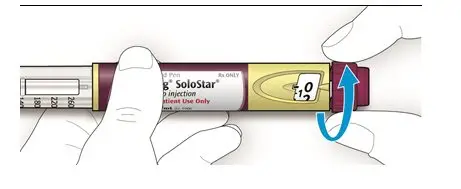
How to read the dose window
Even numbers are shown in line with dose pointer.
|
|
|
| 20 units selected |
Odd numbers are shown as a line between even numbers.
|
|
|
| 21 units selected |
Units of insulin in your pen:
- Your pen contains a total of 300 units of insulin. You can select doses from 1 to 80 units in steps of 1 unit. Each pen contains more than 1 dose.
- You can see roughly how many units of insulin are left by looking at where the plunger is on the insulin scale.
Step 5: Inject your dose
If you find it hard to press the injection button in, do not force it as this may break your pen. See the section below for help.
5A Choose a place to inject as shown in the picture above.
5B Push the needle into your skin as shown by your healthcare provider.
- Do not touch the injection button yet.
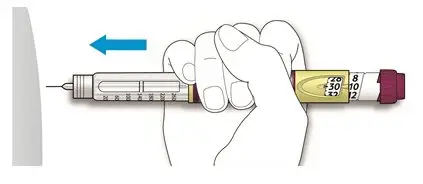
5C Place your thumb on the injection button. Then press all the way in and hold.
- Do not press at an angle. Your thumb could block the dose selector from turning.
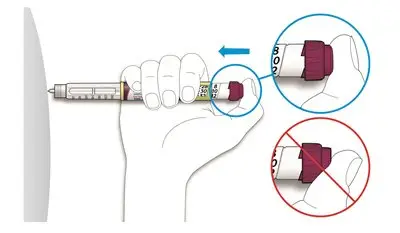
5D Keep the injection button held in and when you see "0" in the dose window, slowly count to 10.
- This will make sure you get your full dose.
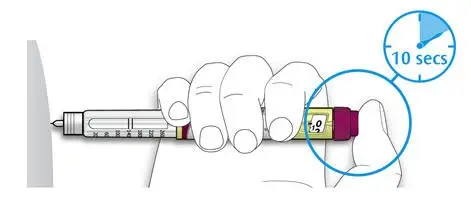
5E After holding and slowly counting to 10, release the injection button. Then remove the needle from your skin.
If you find it hard to press the button in:
- Change the needle (see Step 6 and Step 2) then do a safety test (see Step 3).
- If you still find it hard to press in, get a new pen.
- Do not use a syringe to remove insulin from your pen.
- Take care when handling needles to prevent needle-stick injury and cross-infection.
- Do not put the inner needle cap back on.
6A Grip the widest part of the outer needle cap. Keep the needle straight and guide it into the outer needle cap. Then push firmly on.
- The needle can puncture the cap if it is recapped at an angle.
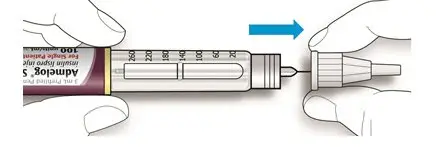
6B Grip and squeeze the widest part of the outer needle cap. Turn your pen several times with your other hand to remove the needle.
- Try again if the needle does not come off the first time.
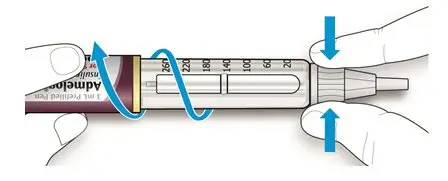
6C Throw away the used needle in a puncture-resistant container (see "Throwing your pen away" at the end of this Instructions for Use).

6D Put your pen cap back on.
- Do not put the pen back in the refrigerator.

How to store your pen
Before first use
- Keep new pens in the refrigerator between 36°F to 46°F (2°C to 8°C).
- Do not freeze. Do not use ADMELOG if it has been frozen.
After first use
- Keep your pen at room temperature below 86°F (30°C).
- Keep your pen away from heat or light.
- Store your pen with the pen cap on.
- Do not put your pen back in the refrigerator.
- Do not store your pen with the needle attached.
- Keep out of the reach of children.
- Only use your pen for up to 28 days after its first use. Throw away the ADMELOG SoloStar pen you are using after 28 days, even if it still has insulin left in it.
How to care for your pen
Handle your pen with care
- Do not drop your pen or knock it against hard surfaces.
- If you think that your pen may be damaged, do not try to fix it. Use a new one.
Protect your pen from dust and dirt
- You can clean the outside of your pen by wiping it with a damp cloth (water only). Do not soak, wash or lubricate your pen. This may damage it.
- Put the used ADMELOG SoloStar pen in a FDA-cleared sharps disposal container right away after use. Do not throw away (dispose of) the ADMELOG SoloStar pen in your household trash.
- If you do not have a FDA-cleared sharps disposal container, you may use a household container that is:
- made of a heavy-duty plastic,
- can be closed with a tight-fitting, puncture-resistant lid, without sharps being able to come out,
- upright and stable during use,
- leak-resistant, and
- properly labeled to warn of hazardous waste inside the container.
- When your sharps disposal container is almost full, you will need to follow your community guidelines for the right way to dispose of your sharps disposal container. There may be state or local laws about how you should throw away used needles and syringes. For more information about safe sharps disposal, and for specific information about sharps disposal in the state that you live in, go to the FDA's website at: http://www.fda.gov/safesharpsdisposal.
This Instructions for Use has been approved by the U.S. Food and Drug Administration.
sanofi-aventis U.S. LLC
Bridgewater, NJ 08807
A SANOFI COMPANY
Revised: November 2019
©2019 sanofi-aventis U.S. LLC
ADMELOG and SoloStar are registered trademarks of sanofi-aventis U.S. LLC.
- 1
- The brands listed are the registered trademarks of their respective owners and are not trademarks of sanofi-aventis U.S. LLC
| ADMELOG
insulin lispro injection, solution |
||||||||||||||||||||
|
||||||||||||||||||||
|
||||||||||||||||||||
|
||||||||||||||||||||
|
||||||||||||||||||||
|
||||||||||||||||||||
| ADMELOG
insulin lispro injection, solution |
||||||||||||||||||||||||||||||
|
||||||||||||||||||||||||||||||
|
||||||||||||||||||||||||||||||
|
||||||||||||||||||||||||||||||
|
||||||||||||||||||||||||||||||
|
||||||||||||||||||||||||||||||
| ADMELOG
insulin lispro injection, solution |
||||||||||||||||||||
|
||||||||||||||||||||
|
||||||||||||||||||||
|
||||||||||||||||||||
|
||||||||||||||||||||
|
||||||||||||||||||||
| Labeler - Sanofi-Aventis U.S. LLC (824676584) |
| Establishment | |||
| Name | Address | ID/FEI | Business Operations |
|---|---|---|---|
| Sanofi-Aventis Deutschland GmbH | 313218430 | ANALYSIS(0024-5924, 0024-5925, 0024-5926) , API MANUFACTURE(0024-5924, 0024-5925, 0024-5926) , LABEL(0024-5924, 0024-5925, 0024-5926) , MANUFACTURE(0024-5924, 0024-5925, 0024-5926) , PACK(0024-5924, 0024-5925, 0024-5926) | |




